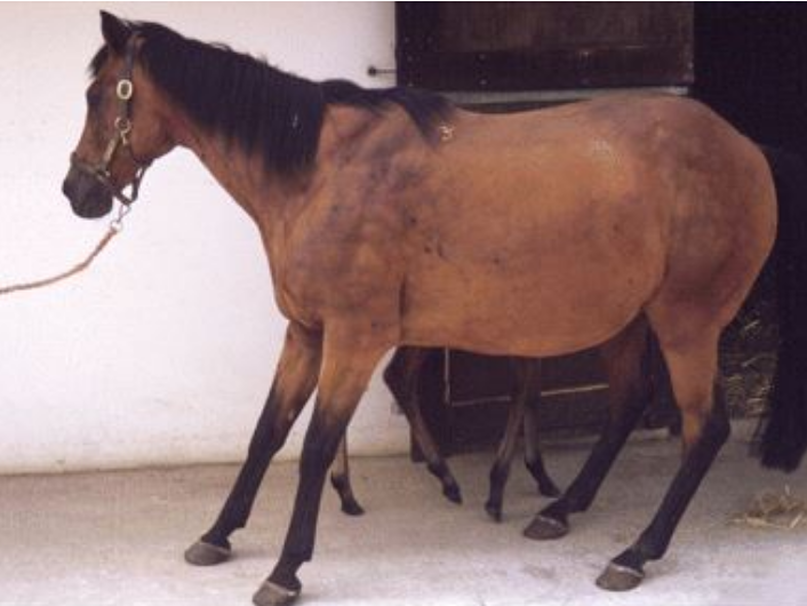Your Horse Has Laminitis. Do You Need to Put Her Down?
Laminitis is treatable-if caught early!
A reader asks, "My horse has laminitis. My friends says I should put her down, but another friends says corrective shoeing will solve the problem. What should I do?"
The short answer is no, you don’t need to put your horse down.
Horses can recover from laminitis, depending on its severity.
What is Laminitis (or Founder) in Horses?
Laminitis is a painful inflammation condition that affects horses' hooves. The tissues (laminae) that bond the hoof wall to coffin bone become inflamed. It is similar to gout in humans, where the joints of the toes (usually the big toe) become enlarged, inflamed, and very painful. When the condition is chronic, it is called founder. The hoof bone actually sinks inside the hoof capsule.
Signs of Laminitis
If your horse is foundering, her hooves feel hot to the touch. The horse will stand leaning back on her heels, as if she's trying to avoid putting weight on her front feet. This stance means your horse's front feet are extremely painful. She will be reluctant to move because her feet are so painful. When she does move, she will appear lame. Foundering horses are often overweight as well. (See photo at the top of this article.)
Also see: How to Tell If Your Horse Is Lame
Causes of Laminitis
The usual culprits in cases of laminitis are too much grain or alfalfa in the horse's diet. Laminitis can also be caused by Cushing's Disease and by endotoxins in the environment.
The short answer is no, you don’t need to put your horse down.
Horses can recover from laminitis, depending on its severity.
What is Laminitis (or Founder) in Horses?
Laminitis is a painful inflammation condition that affects horses' hooves. The tissues (laminae) that bond the hoof wall to coffin bone become inflamed. It is similar to gout in humans, where the joints of the toes (usually the big toe) become enlarged, inflamed, and very painful. When the condition is chronic, it is called founder. The hoof bone actually sinks inside the hoof capsule.
Signs of Laminitis
If your horse is foundering, her hooves feel hot to the touch. The horse will stand leaning back on her heels, as if she's trying to avoid putting weight on her front feet. This stance means your horse's front feet are extremely painful. She will be reluctant to move because her feet are so painful. When she does move, she will appear lame. Foundering horses are often overweight as well. (See photo at the top of this article.)
Also see: How to Tell If Your Horse Is Lame
Causes of Laminitis
The usual culprits in cases of laminitis are too much grain or alfalfa in the horse's diet. Laminitis can also be caused by Cushing's Disease and by endotoxins in the environment.
Treating Laminitis
Cold water hosing, cold packs, anti-inflammatory drugs, and corrective shoeing are all extremely useful in treating an acute case of laminitis.
The most important thing is to get your horse on the correct diet.
Quality grass hay combined with a low starch grain will help your horse recover, and keep her sound. Here are some tips:
Best Horse Feed
Feed Concentrates
How to Prevent Laminitis
Make sure your horse's grain is locked tight in a container that is bug-proof and cannot be opened by a horse fiddling with the latch or cord that seals the feed bin. Horses can be very clever with their teeth and lips, so a padlock, chain, heavy-duty bungee cords that must be stretched and unhooked to remove, or a locked storage closet are the best ways to store grain. Another risk is too much alfalfa in the horse's grazing pasture. This can be fatal.
Happy Riding!
Copyright Denise Cummins, PhD June 5, 2009; Updated June 26, 2024
The Thinking Equestrian
As long as you’re here, check these out!
Equestrian Products That Make Your Riding and Horse Care Easier and Better!
Six Vital Horse Facts That Every Horse Owner Absolutely Must Know
Common Horse Ailments and How to Treat Them
Cold water hosing, cold packs, anti-inflammatory drugs, and corrective shoeing are all extremely useful in treating an acute case of laminitis.
The most important thing is to get your horse on the correct diet.
Quality grass hay combined with a low starch grain will help your horse recover, and keep her sound. Here are some tips:
Best Horse Feed
Feed Concentrates
How to Prevent Laminitis
Make sure your horse's grain is locked tight in a container that is bug-proof and cannot be opened by a horse fiddling with the latch or cord that seals the feed bin. Horses can be very clever with their teeth and lips, so a padlock, chain, heavy-duty bungee cords that must be stretched and unhooked to remove, or a locked storage closet are the best ways to store grain. Another risk is too much alfalfa in the horse's grazing pasture. This can be fatal.
Happy Riding!
Copyright Denise Cummins, PhD June 5, 2009; Updated June 26, 2024
The Thinking Equestrian
As long as you’re here, check these out!
Equestrian Products That Make Your Riding and Horse Care Easier and Better!
Six Vital Horse Facts That Every Horse Owner Absolutely Must Know
Common Horse Ailments and How to Treat Them
Opening Photo Credit: Habitat For Horses https://www.habitatforhorses.org/laminitis-a-crippling-deadly-disease-for-horses-ponies-and-donkeys/

